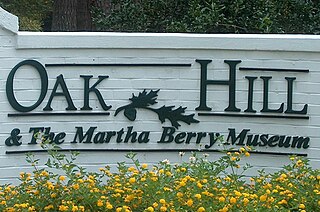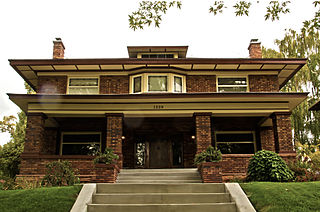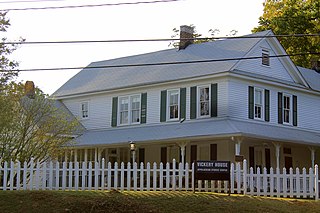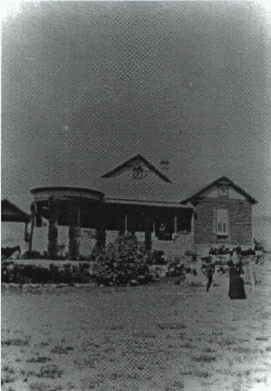
The Eastlake movement was a nineteenth-century architectural and household design reform movement started by British architect and writer Charles Eastlake (1836–1906). The movement is generally considered part of the late Victorian period in terms of broad antique furniture designations. In architecture the Eastlake style or Eastlake architecture is part of the Queen Anne style of Victorian architecture.

A Cape Cod house is a low, broad, single or double-story frame building with a moderately-steep-pitched gabled roof, a large central chimney, and very little ornamentation. Originating in New England in the 17th century, the simple symmetrical design was constructed of local materials to withstand the stormy weather of Cape Cod. It features a central front door flanked by multipaned windows. The space above the first floor was often left as unfinished attic space, with or without windows on the gable ends.

The Lapham–Patterson House is a historic site at 626 North Dawson Street in Thomasville, Georgia. The house, built between 1884-85 as a winter cottage for businessman C.W. Lapham of Chicago, is a significant example of Victorian architecture. It has a number of architectural details, such as fishscale shingles, an intricately designed porch, long-leaf pine inlaid floors, and a double-flue chimney. Inside, the house was well-appointed with a gas lighting system, hot and cold running water, indoor plumbing, and modern closets. Its most significant feature is its completely intentional lack of symmetry. None of the windows, doors, or closets are square. The house is a Georgia Historic Site and is also a National Historic Landmark, designated in 1973 for its architecture. It is also a contributing building in the National Register-listed Dawson Street Residential Historic District.

The Stephen Tyng Mather Home is a historic house and National Historic Landmark at 19 Stephen Mather Road in Darien, Connecticut. It is significant as the longtime family home Stephen Tyng Mather (1867–1930), an industrialist and conservationist who championed the creation of the National Park Service in 1916 and served as its first director. The main house was built in 1778 by his great grandfather, Deacon Mather. Stephen Mather often lived elsewhere, but regarded this house as his true home.

Oak Hill & The Martha Berry Museum is the home and museum about Berry College founder Martha Berry located in Rome, Georgia, United States. It is also an All-America Selections Display Garden, a part of Berry Schools on the National Register of Historic Places, and a AAA Star Attraction.

The Marathon County Historical Museum is museum located in Wausau, Marathon County, Wisconsin, United States. It is located in the Cyrus Carpenter Yawkey House, a house listed on the National Register of Historic Places in 1974. The house is a significant example of Classical Revival architecture.
Hicklin Hearthstone is a historic home located near Lexington, Lafayette County, Missouri. It was built about 1838, and is a two-story, central passage plan, Greek Revival style brick I-house. It has a two-story rear ell and features a one bay wide two story pedimented portico. Also on the property are the contributing five unit dependencies, a two-cell Overseer's cabin, a chicken coop, a smoke house, and a carriage house,. The large transverse barn, situated in front of the house, a brick root cellar house, and an out house no longer exist. The brick dependencies include a Store House, a Carpenter's quarters, a Wash House, a Servant's quarters and a large summer kitchen. The frame slave quarters housed the field hands. These quarters were numerous and scattered on the property, and no longer exist. James Hicklin, one of Lexington's earliest settlers, was a surveyor of roads and plats, settling Lexington with his parents in 1819. He was a skilled farmer as well a skilled entrepreneur. Per the NRHP, There is strong evidenced that he amassed his fortune through slave trading, the index of that is the decline of his fortune post the Civil War. Per Ancestry and the 1850 and 1860 Slave Schedules, Hicklin owned 33 slaves in 1850 and 19 slaves in 1860, their ages ranging from 1-50. Several of the enslaved workers stayed after they were freed in January, 1865, and took the name Hicklin as their own. This was not the case for all of the people enslaved by James Hicklin. Per NRHP, One of his workers was branded a fugitive, while another fractured Hicklin's skull in 1853, which would imply reason to doubt any supposed charity or benevolent nature of James Hicklin. He passed in 1875.

The Newcomb–Brown Estate is located at the junction of the US 44 highway and Brown Road in Pleasant Valley, New York, United States. It is a brick structure built in the 18th century just before the Revolution and modified slightly by later owners but generally intact. Its basic Georgian style shows some influences of the early Dutch settlers of the region.

The Oliver Barrett House is located on Reagan Road in the Town of North East, New York, United States, south of the village of Millerton. It is a frame farmhouse built in the mid-19th century, possibly on the site or with materials from another, older house. In the early 20th century it underwent substantial renovations, particularly of its interior. Later in the century it was subdivided into rental units, a conversion reversed by more recent owners.

The Davenport House, also known as Sans-Souci, is an 1859 residence in New Rochelle, New York, designed by architect Alexander Jackson Davis in the Gothic Revival style. The "architecturally significant cottage and its compatible architect-designed additions represent a rare assemblage of mid-19th through early 20th century American residential design". The house was listed on the National Register of Historic Places in 1980.

The Hyrum T. Covey House is a historic house in northeastern Salt Lake City, Utah, United States, that is located within the University Neighborhood Historic District, but is individually listed on the National Register of Historic Places (NRHP).

The David Adler Estate was the house and property of American architect David Adler in Libertyville, Illinois, United States. It is the house most closely associated with his life and career.

Weetwood is a heritage-listed Georgian style villa at 427 Tor Street, Newtown, Toowoomba, Toowoomba Region, Queensland, Australia. It was designed by architect James Marks and built from 1888 onwards. It was added to the Queensland Heritage Register on 21 October 1992.

Fields Place-Vickery House is a historic building located in Dahlonega, Georgia. It is listed on the National Register of Historic Places.

The Foster-Redington House is a historic house at 8 Park Place in Waterville, Maine. Built in 1883, it is a fine example of Queen Anne architecture, supposedly the city's first example of the style. It was built by Moses Coburn Foster, a well-known builder in the state, as his private residence. Moses owned M.C. Foster & Son, general contractors and builders. An advertisement for the business lists its location as 7 Park Place, which was the home built for his son, Herbert Foster. Herbert died at 38 years old. Herbert's home is as unique as Moses' but has not been restored, but instead, turned into two apartments.

The Amos Deason Home is located in Ellisville, Mississippi. Completed in 1845, it the oldest home in Jones County, Mississippi and is located at 410 Anderson Street.

The Henry M. and Annie V. Trueheart House is a residence of historic significance located in the town of Fort Davis, the seat and largest town of Jeff Davis County in the U.S. state of Texas. The house was built in 1898 and, along with the surrounding property, was added to the National Register of Historic Places (NRHP) in 1996. The Trueheart House has also been distinguished as a Recorded Texas Historic Landmark (RTHL) since 1964.

The Grange and Macquarie Plains Cemetery are a heritage-listed homestead and cemetery at 3249 O'Connell Road, Bathurst, Bathurst Region, New South Wales, Australia. It was built from 1830 to 1836, probably by convict labour. It was added to the New South Wales State Heritage Register on 15 March 2013.

The Almond A. White House is a historic house in Motley, Minnesota. Built in 1902, the Queen Anne architecture is unique compared to other buildings in the town, and locally, it is referred to as the Motley Castle. Believed to be built as a rural retreat for Mr. A.A. White, a lumber businessman, the house remains a showplace in Motley, and was added to the National Register of Historic Places on March 13, 1986.



















